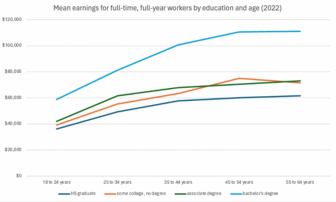
A year ago I wrote about the year two results from the MDRC evaluation of the Detroit Promise Plus program. This post is largely a rerun of that post with data updated for year three of the program. The bottom line unfortunately remains the same: we have an ongoing community college completion challenge.
The headline from the new report is that only 11 percent of program participants who enrolled in a participating community college earned either a certificate or Associates Degree in three years. All of the program participants received free tuition and fees.
The Detroit News published an extensive summary of the results of the first three-year Detroit Promise Plus program. Highly recommended! Their conclusion:
For educators, it’s the latest indication that the barriers to finishing a higher education for historically disadvantaged populations will be more difficult to overcome than by providing free tuition coupled with a meager stipend and counseling assistance.
Here is my 2019 post with updated data:
The recently released MDRC evaluation of the Detroit Promise underscores the community college completion challenge. Despite free tuition and fees, only 11 percent of students who started in the program earned a credential––either a certificate or Associates Degree––in three years. There was virtually no difference in completion rates between those who in addition to free tuition also received addition financial support and most importantly intensive coaching/counseling. Which is a particularly disappointing result given the substantial increase in completion rates of the CUNY ASAP program which served as the model for Detroit Promise Plus program.
About 36 percent of program participants that did not earn a credential in three years were still enrolled in either a community college or four-year university in the last semester of the third year.
The above paragraphs in no way are meant as a criticism of the program. The Detroit Regional Chamber deserves a lot of credit for initiating the Detroit Promise and partnering with MDRC to add financial incentives and supports. Rather, the purpose of the opening paragraphs is to make clear that the challenge of significantly improving community college completion rates requires far more than free tuition or even free tuition combined with mandatory and intensive student supports.
It also is true that the Detroit Promise participants are, almost certainly, a cohort who enter college with the greatest completion challenges. Program participant live in the City of Detroit and have graduated from any high school located in the city. Many will have entered college with some combination of serious academic challenges; financial challenges far beyond the ability to pay for tuition; and a variety of non-academic challenges.
But the above are challenges, not acceptable reasons/excuses for low completion rates. Higher education institutions need to be designed for success of all students.
This is the central thesis of Redesigning America’s Community Colleges. Its authors––all from the Community College Research Center at Columbia University––write:
Community colleges were designed to expand college enrollment, particularly among underrepresented students, and to do this at a low cost. They have been extraordinarily successful at achieving those goals. However, colleges designed to maximize course enrollment are not well designed to maximize completion of high quality-programs of study. In particular colleges offer an array of often-disconnected courses, programs and support-services that students are expected to navigate on their own.
… Instead, they need to engage faculty and student services professionals in creating a more clearly structured, educationally coherent program pathways that lead to students’ end goals, and in rethinking instruction and student support services in ways that facilitate students’ learning and success as they progress along these paths. In short, to maximize both access and success, a fundamental redesign is necessary.
The MDRC two-year Detroit Promise evaluation report was entitled A Path from Access to Success. Success––not access––by all students needs to become the mission of community colleges (actually all education institutions). And that needs to be accompanied by an understanding that to achieve that mission involves fundamental redesign of community colleges.
As we detailed in a previous post Redesigning American’s Community Colleges lays out four fundamental areas where redesign is required to improve completion rates and labor market outcomes:
- Redesign from a cafeteria-style self-service model to a guided pathways model. Moving from students largely on their own in choosing from a multitude of courses and credentials to limiting student choice to “educationally coherent pathways, each with clearly defined learning outcomes that build across the curriculum and are aligned with requirements for education and career advancement in the given field.”
- Guiding students. What the book calls intake and student supports. This involves moving to intensive and mandatory student counseling. Everything from helping students pick a pathway or a program that leads to a good-paying job and career; to staying on top of student progress and intervening when a student is experiencing difficulties in staying on track no matter if the reason is academic or otherwise; and to providing high-quality job placement services for those who earn credentials.
- Moving student instruction from lecture/imparting content to a “learning facilitation approach to instruction, which focuses on building students’ academic motivation and metacognition”.
- Dealing with unprepared students through a complete redesign of developmental education.
So the main lesson we need to learn from the Detroit Promise to date is the community college completion challenge will require fundamental change in the mission and design of community colleges. Anything less will, almost certainly, leave us far short of Governor Whitmer’s goal of 60 percent of Michigan adults by 2030 with a post-secondary credential of value. And, probably even more importantly, far away from the goal of higher education as the path to equal opportunity for all.







